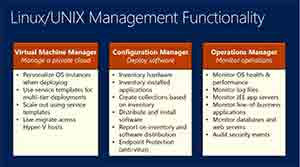News
Microsoft Building Up Hyper-V Management Support for Linux and Unix Servers
Microsoft this month talked about how its latest Hyper-V and System Center 2012 R2 improvements can help with the management of Linux and Unix servers.
Michael Kelley, a lead program manager for Microsoft's Open Source Technology Center, described a scenario that once might have seemed blasphemous at Redmond. He said that managing the private cloud was not just limited to Windows, and that Microsoft was working to provide the tools to support heterogeneous datacenters, including those running Linux and Unix.
"That's the reality of what's out there in the world," Kelley said, in a June 3 TechEd session.
He explained that Microsoft has been adopting this approach for about the last four or five years. Microsoft has a large market share of Windows Server on x86 hardware, but 25 percent of System Center Operations Manager installations are used for managing Linux and Unix alongside Windows Server. "We are going to compete with the heterogeneous cloud," he said.
Microsoft products currently support six server-based Linux distros, including Red Hat Enterprise Linux, SUSE Linux Enterprise Server, CentOS, Ubuntu Server, Debian and Oracle. On the Unix side, Microsoft supports IBM AIX, HP-UX and Oracle Solaris. The support falls across several Microsoft products, including System Center Operations Manager, Configuration Manager, Endpoint Protection, and Virtual Machine Manager, as well as Hyper-V and Windows Azure Infrastructure Services, with some exceptions (see table).
 [Click on image for larger view.] Figure 1.Microsoft support for Linux and Unix server operating systems. Source: Microsoft TechEd, June 3, 2013.
[Click on image for larger view.] Figure 1.Microsoft support for Linux and Unix server operating systems. Source: Microsoft TechEd, June 3, 2013.
Microsoft's support plans are more limited on the Unix side, Kelley said. He added that Microsoft has "no plans, really, to take the Unix operating systems into that full private cloud environment."
Improvements for Linux and Unix
The improvements that Microsoft is bringing with the new Hyper-V in Windows Server 2012 R2 also apply to managing Linux and Unix systems. Examples offered by Kelley included faster live migrations and network virtualization benefits. He also described dynamic memory support, the ability to dynamically resize VHDs and VHDXs, a new two-dimensional synthetic video driver and the ability to use replicas of Linux-based virtual machines (VMs) for disaster recovery. A different TechEd session, focused on new Hyper-V improvements, even suggested that "Microsoft now has the best backup story for Linux."
The dynamic memory capability can be used to scale a workload on a Web server. As a workload increases, memory gets dynamically added to the VM. As a workload drops, the hard-added memory remains the same.
The ability to dynamically resize a VHD is the ability to expand or contract it on the fly. Users can go into the Hyper-V console and select a particular VM to change its storage size.
Disaster recovery support is enabled via Hyper-V replica, a feature of Windows Server 2012 and Windows Azure. With the Hyper-V replica scenario, there is a primary site and recovery site, as well as a channel between them to support failover operations.
For more on Microsoft's System Center product capabilities that support Linux and Unix, see the following chart presented by Kelley at his TechEd session.
 [Click on image for larger view.] Figure 1. System Center management support for Linux and Unix. Source: Microsoft TechEd, June 3, 2013.
[Click on image for larger view.] Figure 1. System Center management support for Linux and Unix. Source: Microsoft TechEd, June 3, 2013.
System Center has access to gallery of prebuilt OS templates to choose from, but the Linux distros located in the gallery are created and maintained by the distro providers, who also provide technical support for the OSes. Technical support on running Linux using Hyper-V is provided by either by Microsoft or by the Linux vendor.
Microsoft adds Linux support through its "Linux integration services." The Linux integration services are typically built into the OS, or are offered as a download from Microsoft. Kelley noted a couple of new developments along those lines. Red Hat Enterprise Linux versions 5.9 and 6.4 now have Microsoft's Linux integration services built into them. In addition, Debian 7.0 now has built-in Linux integration services.
Use of Open Protocols
As part of its Linux integration services efforts, Microsoft writes a System Center Virtual Machine Manager agent for Linux, which must be preinstalled in the Linux OS, Kelley explained. Microsoft's agent for Linux or Unix computers used to be based on OpenPegasus, but now it's based on the Open Management Infrastructure (OMI) approach. Kelly described OMI as the "equivalent of the WMI service in Windows." He added that "you're going to see OMI rolled more into Windows going forward."
The Microsoft agent on the Linux or Unix machine is "very light, and it's open source," Kelley said. Microsoft took that approach to make it more comfortable for open source users to run Microsoft software on their Linux or Unix machines, he explained.
Microsoft uses the Secure Shell (SSH) networking protocol to do agent maintenance. Users don't have to use SSH, but can use some other tool. Monitoring happens using the WS-Management protocol.
Microsoft provides management packs for managing Java Platform Enterprise Edition (JEE) application servers. Linux support includes JBOSS (versions 4.2, 5.1 and 6.0), Tomcat (versions 5.5, 6.0 and 7.0), WebLogic (versions 11g Rel1 and 10g Rel3) and WebSphere (versions 6.1 and 7.0). The support includes custom MBeans for health and performance monitoring, memory use, garbage collection and discovery. Microsoft also supports WebLogic on Oracle Solaris and WebSphere on IBM AIX.
About the Author
Kurt Mackie is senior news producer for 1105 Media's Converge360 group.